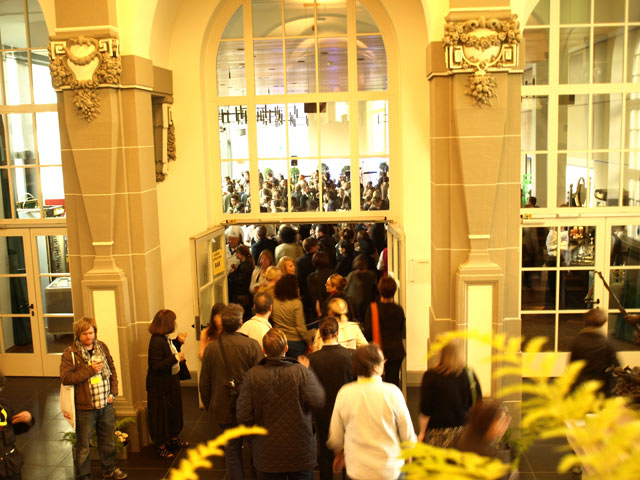 My trip started in May with Hamburg. I was invited as a guest lecturer at the University, introduction to curatorial practice focusing onto a specific artist: Luis Vidal from Spain. I was positively surprised about the ambitions and high intellectual energy of the students, but shocked by the treatment of culture and art in Hamburg lately. I thought Spain was a nightmare, but seeing that Hamburg, the city with the highest density of millionaires and billionaires in Germany, is struggling financially and cutting first of all in culture, leaving the city in a mediocre artistic and cultural state, was quite a surprise for me. I haven’t seen one exhibition which impacted or inspired me. And, please forgive, the huge entertainment area of Anthony Gormley in the Deichtorhallen was such an obvious dedication to the supporters of this artist, that the public institution Deichtorhallen should be ashamed. It seems that they try to follow the US American system now, but the German institutions still have a public mission, they are still financed by public money. Even if this is not as much as before, it is still possible to produce interesting and inspiring exhibitions instead of selling the space completely to a certain lobby.
My trip started in May with Hamburg. I was invited as a guest lecturer at the University, introduction to curatorial practice focusing onto a specific artist: Luis Vidal from Spain. I was positively surprised about the ambitions and high intellectual energy of the students, but shocked by the treatment of culture and art in Hamburg lately. I thought Spain was a nightmare, but seeing that Hamburg, the city with the highest density of millionaires and billionaires in Germany, is struggling financially and cutting first of all in culture, leaving the city in a mediocre artistic and cultural state, was quite a surprise for me. I haven’t seen one exhibition which impacted or inspired me. And, please forgive, the huge entertainment area of Anthony Gormley in the Deichtorhallen was such an obvious dedication to the supporters of this artist, that the public institution Deichtorhallen should be ashamed. It seems that they try to follow the US American system now, but the German institutions still have a public mission, they are still financed by public money. Even if this is not as much as before, it is still possible to produce interesting and inspiring exhibitions instead of selling the space completely to a certain lobby.
So after 10 days spending in my lovely, yet less inspiring home city, I was happy to close my suitcase and move on. First to Oldenburg to do a studio visit in the middle of nowhere at Insa Winkler’s place, an environmental artist with an interesting focus onto landscape and philosophy, including the visit of the Horst Janssen Museum. Sometimes provincial cities have more verve than the big centers, and are more authentic.
After recovering in plain nature for a couple of days I jumped into the long awaited Documenta adventure. I was lucky to attend the press opening days when a lot of participating artists were present and some interesting panels were held. I was very curious about the actual exhibition after having followed the press opinions, all condemning the Artistic Director Carolyn Christov-Bakargiev of being arrogant and too intellectual, everybody prejudging this year’s Documenta. I knew about the participation of some very interesting artists before and preferred to wait and see the results. And I have to say: Documenta 13 rocks!
Though Carolyn Christov-Bakargiev defended her exhibition as a one without any concept, she transformed the konzeptlosigkeit into a concept. While plunging into the numerous artistic projects, it became obvious that the overall ausstellung yes indeed had a concept. She explained that very clearly during the panel about the results of the Afghan seminars, which took place in the Staendehaus on June 7: Her only way of doing the Documenta was from inside AND outside. It was impossible for her to produce a show in Kassel exclusively, she did not only want to connect the exhibition with the world, but bring it to the world and bring the world and its conflicts through specific art projects to Kassel. Through particularly very challenging workshops and seminars in Kabul and Bamiya (Afghanistan), and later Alexandria and Cairo (Egypt) and Banff (Canada) she engages artists to think and work about nature, destruction, war, loss of history, science, sustainability, and solutions for transcultural conflicts. Very engaging and mind-opening. The results, after all, have to be examined, some critics are unfortunately already talking about empty meetings, only serving as an excuse for the participating curators and artists to travel to interesting places.
The opening reception at the Town Hall reflected the absurd of Kassel: From the magic of transcultural and international during the exhibition to the spiessig (suburban) and provincial of the reception where whole Kassel seemed to be meeting, later on some international guests joined the gathering, but most of them sat outside on the beautiful stairs with a drink in the hand and the humble gesture of hanging out on the floor instead of promenading on the red carpet. I enjoyed meeting people like Cassandra Bird, an Australian curator based in Berlin, who is co-director of momentum, or Christian Wassmann, the Swiss architect based in New York who collaborated with the artist Michael Portnoy for is huge dOCUMENTA installation at the Kulturbahnhof. Or Yehuda Safran, the renown architect based in New York. We had the best pizza ever in Kassel in the worst and most unfriendly place ever, sitting on the sidewalk of a road where everybody passed by to get to the big party at the Alte Bruederkirche. The international art scene as always gathered in the middle of nowhere.
Theaster Gates, the multifaceted urbanist, singer, designer, preacher and visual artist from Chicago, presented at the Huguenot House, a former hotel, an intriguing project, Twelve Ballads for Huguenot House, taking over the whole building and transforming the individual rooms into installations using pieces from an old school in Chicago. During the opening days the rooms were lined with performances by the Black Monks of Mississippi. I am still laughing about the comment of a well acclaimed German art journalist writing in an important newspaper about this work mentioning that “there were also some bands playing”. He obviously didn’t understand the entire and complex work at all, but at least enjoyed the music. Well. The project explores the relationship between social enterprise, contemporary art practices, and cultural redevelopment.
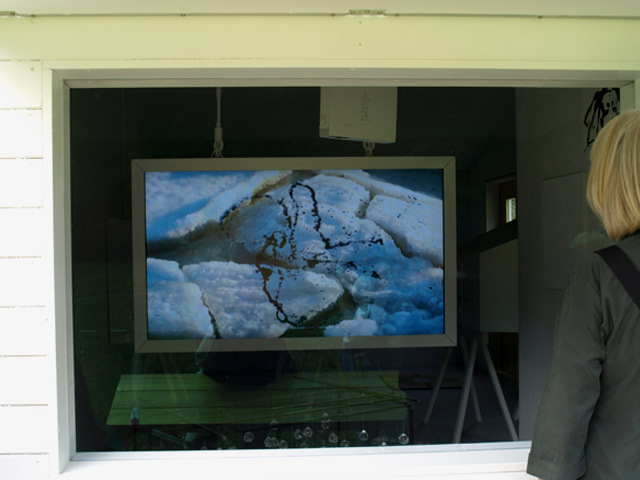
I loved the installations in the Karlsaue Park. Particularly the multi-dimensional box-theater work of Joan Jonas’ “Humans are prevailing”, a 4- channel-video work with drawings and small theater-like installations in one of the park datschas where she shows the destruction of nature, the melting of the pole caps, mass animal production and indigenous references, an impacting work based on the Novel “Under the Glacier” (1968) by Icelandic writer Halldór Laxness. Or the sound installation “Forest (For a Thousand Years)” by Janet Cardiff and George Bures Miller which embraced the visitor in a spherical sound-field with a symphony of natural sounds, classical and choir music (including Arvo Pärt’s Nunc dimittis), war bombardments.
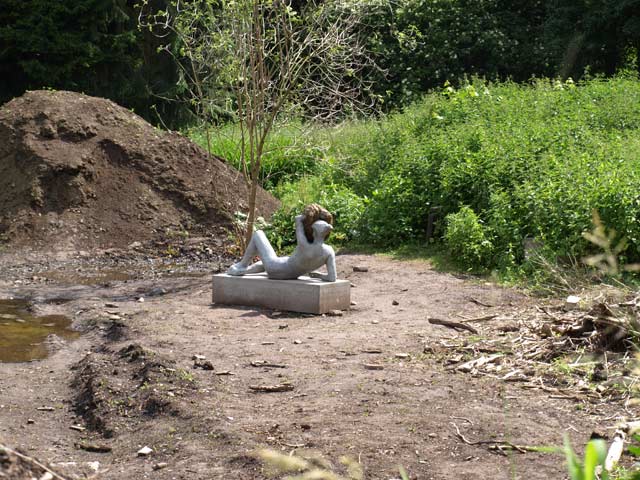 Or Pierre Huyghe’s bee and dog installation, where he created his personal biotope with a roman-like lying female sculpture carrying a beehive obscuring her head and a meandering dog with a pink leg, bringing nature and the idea of nature (bees as a symbol for an intact environment, criticizing the human structure and way of thinking by replacing the part of a human body, which is understood as the capital part, by a natural structure known for its extreme effectiveness and respect in between beings: a beehive) back to the art. Of course, a lot of visitors and readers were laughing about and stultifying the fact that the curator is focusing on dogs and animals in her exhibition. But it is done in such a subtle and smart way, with an intellectual approach containing humor and transmitting a specific spirit, that all critique becomes obsolete.
Or Pierre Huyghe’s bee and dog installation, where he created his personal biotope with a roman-like lying female sculpture carrying a beehive obscuring her head and a meandering dog with a pink leg, bringing nature and the idea of nature (bees as a symbol for an intact environment, criticizing the human structure and way of thinking by replacing the part of a human body, which is understood as the capital part, by a natural structure known for its extreme effectiveness and respect in between beings: a beehive) back to the art. Of course, a lot of visitors and readers were laughing about and stultifying the fact that the curator is focusing on dogs and animals in her exhibition. But it is done in such a subtle and smart way, with an intellectual approach containing humor and transmitting a specific spirit, that all critique becomes obsolete.
The documentation about art and culture in Afghanistan in the Oberste Gasse 4 was extremely impacting, not everything, but overall the Afghan film archive, yes, the entire one with 1219 + 101 films. How could that be possible? How did they recover them?
In the Kulturbahnhof (side wing of the main station) you find the multi-part installation “The Pixelated Revolution” by Lebanese artist Rabih Mroué which show
s the video documentation of the moment when Syrian civilians are shot, filmed by the victims themselves with their own cell phones. The artist found this footage on the internet which documents the recent violent movements in Syria. The victims collapse armed only with their cell phone. An impacting work which puts every other work you have seen before, particularly by extremely commercial orientated artists, into a different angle.
For the ones who didn’t go to Kassel (a non-attractive provincial town in the middle of nowhere, indeed, but only 1,5 hours away from Frankfurt if you take the comfortable fast train ICE) yet: I can only recommend this excursion, if you happen to be in Europe in summer.
And now from the spirit to the commerce part of my trip:
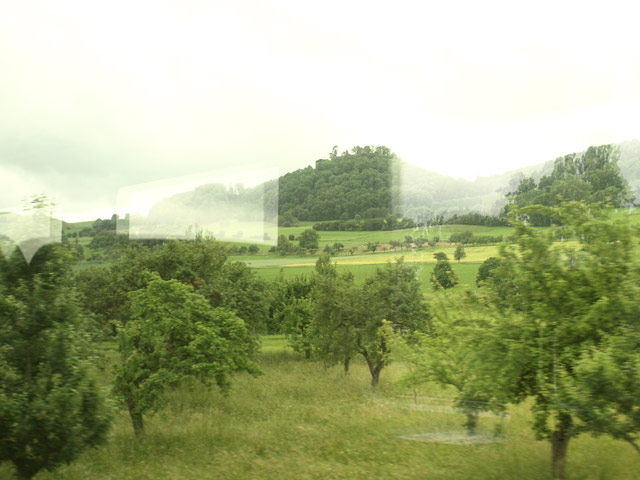 The rain had been following me since Hamburg. After a short stopover in Frankfurt, the ICE took me to Switzerland through the lovely and poetic landscape of Southern Germany, the sun coming out every once in a while which, contemplating the forests, meadows and rivers passing by, reminded me of the lyrics of Goethe. Zurich welcomed me with heavy showers, but I enjoyed some gallery visits (Elger Esser at Katz Contemporary was very aesthetical) and the new Löwenbräu Areal, a former brewery transformed into a rich modern contribution to the cultural life of the city. Though I have to admit that the art I saw was intellectually not particularly overwhelming but quite safe and economically without any risks, fantastic blue chip investments. Kunsthalle Zurich showed its collection which rather seemed to be a potpourri of the latest most famous artists, though no first class works, a weird way of collecting. The new premises of Hauser & Wirth was, on several floors, part of the big cement accumulation, it still smelled recently constructed, a smell which causes a feeling of suffocation, I don’t recall why. The mint tea together with the Costa Rican Zurich based artist Cinthya Soto at the Moroccan Tea Room nearby was the best of the day maybe.
The rain had been following me since Hamburg. After a short stopover in Frankfurt, the ICE took me to Switzerland through the lovely and poetic landscape of Southern Germany, the sun coming out every once in a while which, contemplating the forests, meadows and rivers passing by, reminded me of the lyrics of Goethe. Zurich welcomed me with heavy showers, but I enjoyed some gallery visits (Elger Esser at Katz Contemporary was very aesthetical) and the new Löwenbräu Areal, a former brewery transformed into a rich modern contribution to the cultural life of the city. Though I have to admit that the art I saw was intellectually not particularly overwhelming but quite safe and economically without any risks, fantastic blue chip investments. Kunsthalle Zurich showed its collection which rather seemed to be a potpourri of the latest most famous artists, though no first class works, a weird way of collecting. The new premises of Hauser & Wirth was, on several floors, part of the big cement accumulation, it still smelled recently constructed, a smell which causes a feeling of suffocation, I don’t recall why. The mint tea together with the Costa Rican Zurich based artist Cinthya Soto at the Moroccan Tea Room nearby was the best of the day maybe.
Next morning train to Basel and first stop Volta Art Fair. I was rather disappointed regarding the general gallery presentations and specifically about the art works shown. I wonder how the selection process has been done lately. Some exceptions though have to be highlighted: The work of Jordi Alcaraz and Jason Gringler at Stefan Röpke Gallery from Cologne, at espaivisor from Valencia particularly the overwhelming pieces of Nil Yalter which juxtaposed photography and drawings talking about the early immigration trauma of Turkish people in Paris, an era which has never been documented or highlighted in contemporary art so far and which is reflecting the transcultural issue in Europe at a very early stage. The Cambodian artist Sopheap Pich, who shows at Documenta 13 as well, at Tyler Rollins, a wonderful creation of geometrical sculptures made of natural and local Cambodian material, referencing political and social issues in Cambodia. I also liked the work of Angel Marcos, an installation of photographies and light boxes reflecting Senegalese culture, everyday life, beauty and authenticity.
Arriving at Art Basel, the first thing which impacted physically, were the huge construction sites outside the buildings, the dust, the dirt, the noise and the hugeness of the site and the technical equipment. I think I have never seen this size of excavators before in my life.
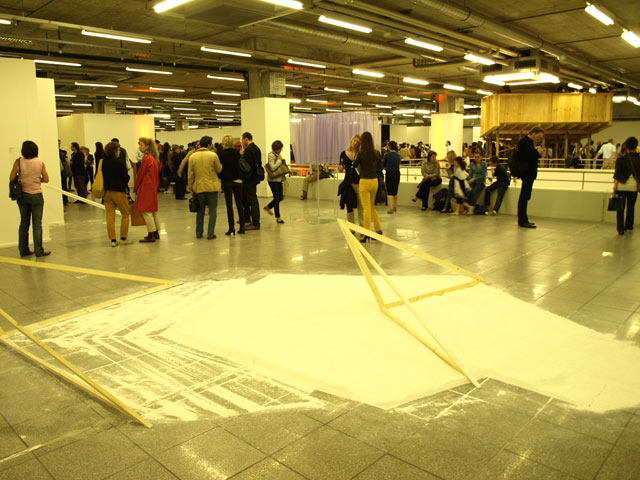
We started at Art Statements which was not convincing to me, the overall quality not what I expected. I wonder again how the fair direction could let that happen. In the section Art Unlimited at Art Basel I had a pleasant encounter with the work of Pier Paolo Calzolari, the Italian artist who showed at Marianne Boesky and Pace Gallery in New York in May. A poetic, minimal frost installation consisting of six found mattresses mounted upright with a refrigerating system, recalling the aesthetics of arte povera at its best.
The main fair consisted, as always, of la crème de la crème of the international business. And I am not going to repeat what other colleagues have written about these positions. I fell in love again with the work of Benin artist Meschac Gaba, in this case a solo show at the booth of insitu Gallery Paris: The part “Couvre-chef” of the Musée d’Art de la Vie Active (MAVA). The gallery’s text written by renown African critic and curator Simon Njami defines the work in a very expressive way: “By crossing identity and racial boundaries, Meschac Gaba’s project goes much further as he portrays a fresco of humanity with braided hairstyles. His message is clear: there are men who have worked for the good of all humanity, no matter where they came from. In that sense Gaba reminds us that there is a united and indivisible community making the world a little less harsh. Nowadays, self gratification or nationalisms of all sort imperil the foundations of an ideal that should be shared by all. Gaba quite naturally takes things further since the wigs portraying these grandees are hair extensions that unambiguously recall Africa to mind. Is this an effort to remind us that Africa is the cradle of humanity and that we should all therefore think of ourselves as its children? In the same way that May ’68 students all called themselves German Jews in solidarity with Daniel Cohn-Bendit who was ostracized by the powers of the day, Gaba declares us all Africans.”
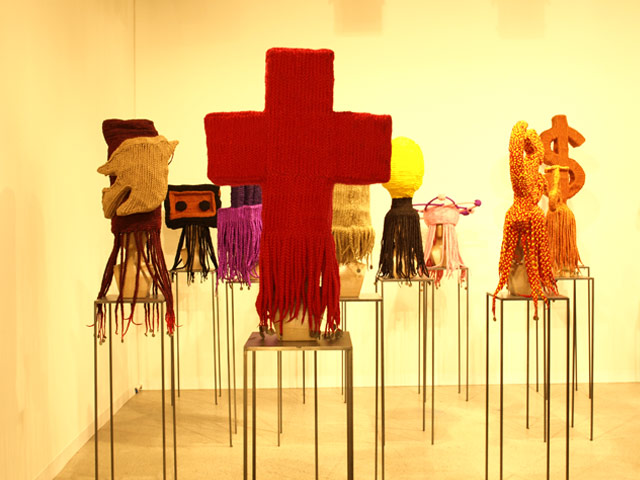
The Art Parcours, curated again by Jens Hoffmann, contained one work which I particularly liked: “150 People” by the Cuban group Los Carpinteros in the Prediger Church. The work was the bridge to Meschac Gaba’s MAVA project, a reflection of transcultural identity, human diversity and religion.
The Vitra Design Party drowned in the rain, white umbrellas donated by Vitra served for a public art installation where the visitor became part of a happening without intention. It was pouring dogs and cats. But the food and the wine, the conversations, the laughter and the art installations were as delicious as always.
The Jeff Koons talk at Fondation Beyeler brought together the contemporary art flock from all over the world including the Rubells. And the talk with the artist didn’t reveal anything new. Though the superficial, as to me, works of everyone’s baby Koons were put into a different light by juxtaposing them with a meaningful exhibition by Philippe Parreno, the choreography-like staging of two films, Continuously Habitable Zones aka C.H.Z (2011), and Marilyn (2012). The visitor is guided through the exhibition by sounds and images. At the museum entrance the visitor receives the DVD containing both films including the soundtrack produced by Arto Lindsay, a fantastic option of carrying a museum exhibition back home.
And needless to mention the accumulation of famous, beautiful and important people of the international art community during all these days including Baywatch star Pamela Anderson, I don’t recall the reason why she was in Basel, another example of absurd appearances.
I left Basel, Switzerland and then Germany after an enriching and mind-opening journey which had given me back the faith in art and its meaning by realizing that there is a huge community which believes in art’s responsibility for contributing to a positive transformation of society in general by sensitizing even the ones who refuse to see and accept this function of contemporary art.
Anne-Marie Melster
Co-Founder & Co-Director Spain
Artport_making waves
www.artport-project.org

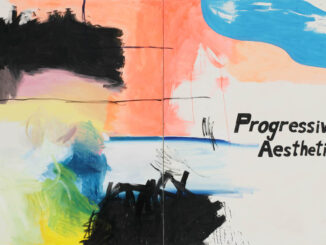
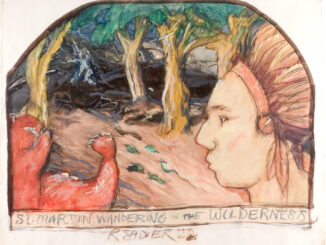
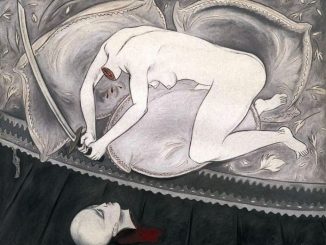
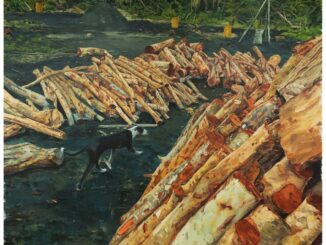
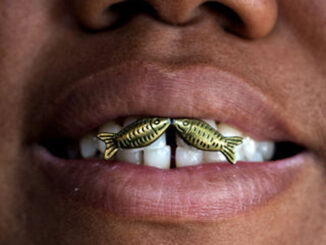
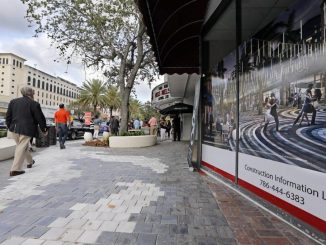
Be the first to comment